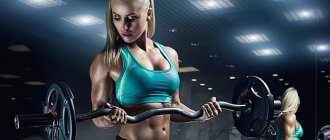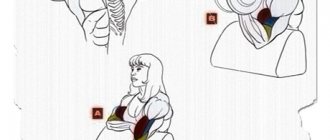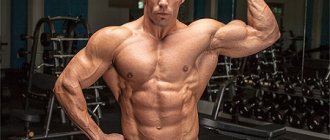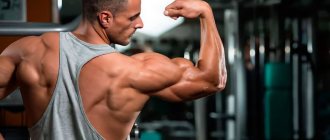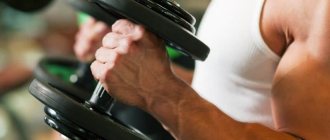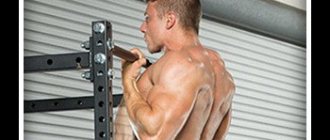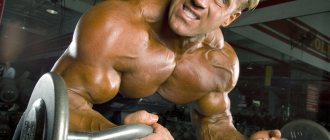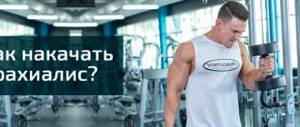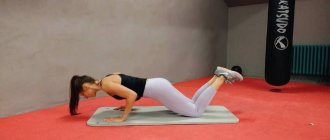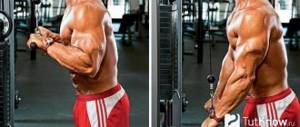“What, biceps again? Well, how much can you write about him?!” - some impatient readers will exclaim. Yes, we are again turning to the topic of development of the biceps brachii muscle, but this time we will not consider its entirety, but only one small area - the bottom. After all, the biceps is not only a peak, the main effort is often directed towards achieving it. In order for this muscle to look harmonious, it must have almost the same thickness along its entire length. But not everyone can achieve this thickness in the lower part and not always.
Correcting nature's mistakes
The general appearance of a particular muscle is determined genetically. The most important factors are the number of fibers in the muscle and their thickness, the length of the tendon with which the muscle is attached to the bone, as well as the point of attachment of this tendon. If you manage to change the last two parameters, then only operationally. But it is still possible to try to change the general appearance of the muscle - by purposefully influencing its individual areas. Such a famous coach as Oscar Ardon, who trained, in particular, Kai Greene and Evan Centopani, insists on this. Centopani believes - and not without reason - that a targeted impact on the middle of the biceps occurs if in the initial position the arm is lowered straight down. If you need to “load” the bottom of the biceps, then in the initial position the angle between the arm and the body should be 45-60 degrees. That is, curls should be performed on a Scott bench or in a biceps machine. You can also perform barbell curls while seated—in the starting position of this exercise, the arms and barbell rest on your hips. But Charles Glass, in order to shift the emphasis to the lower biceps, suggests recalling such a now half-forgotten exercise as standing barbell curls with “pull-ups”. When performing this exercise, the bar slides along the body, and the elbows are pulled back. At the top point of the amplitude of movement, the bar of the bar does not reach the lower section of the chest.{banner_st-d-2}
Minimum set of home training equipment
If you have motivation (and this is the main thing), it’s time to think about training equipment. Not everyone can afford to purchase a machine with a dialing rod. But almost anyone can buy a horizontal bar and hire a craftsman with a hammer drill to securely fasten it.
You will also need a stackable dumbbell, or better yet, two. An expander will also come in handy. If you have a narrow chair with durable wooden railings in your home, you can also use it as an exercise machine. A regular stool will also come in handy for your biceps and triceps exercises.
For further progress in training using a horizontal bar, it may be useful to have additional weights in the form of a regular backpack, inside of which there is a plastic bag with sand of the weight you need.
Brachialis
Under the biceps - in its lower part - is the brachialis. By developing this muscle, we ensure that the biceps is pushed upward. This is especially true for its lower part. There are not many exercises for the targeted development of brachialis, but they exist. In particular, dumbbell curls with a hammer grip are considered one of the best. But there is an exercise that gives a much better result: bending your arms behind your head on an overhead block.
This exercise is performed as follows: you grab the handle of the upper block with a narrow lower grip (I hope you understand which block we are talking about: the one in which you usually perform back exercises), sit down, lean forward and begin to bend your arms behind your head. At the same time, your elbows diverge to the sides. Find a position where you can lower the handle as low as possible, almost touching your neck.
About motivation
Why did we start with motivation? Yes, because the effectiveness of home training depends solely on the ability of the practitioner not only to plan approaches and sets, but also to strictly practice all the planned exercises.
It's no secret that working out at home is more difficult than in the gym. There are many temptations here: delicious food, a home gaming PC, and who knows what else! A house is a house. And here you need to devote one and a half to two hours to strength exercises! Let's face it, not everyone succeeds.
A certain amount of perseverance is important here. Therefore, we insist that on the eve of planning the training process, you convincingly formulate your motivation: why you want to build up your biceps and triceps. It should be as individual as possible.
So there you have it! Amazing. This will be your first entry in your training log.
Short head of biceps
The biceps, as you certainly know, consists of two heads - long and short. From the point of view of the author of this article, the development of the lower part of the short head has priority - since it is somewhat shorter, it is precisely because of its insufficient development that a “failure” will be observed in the lower part of the biceps. Bending the arms with a barbell with a wide and very wide grip allows you to focus on the short head. And if we take into account everything said in the first chapter of this article, we can highlight an exercise that is almost of paramount importance for the development of the lower biceps: curling the arms with a barbell on a Scott bench with a very wide grip. At the same time, we work in a limited amplitude, excluding about a third of it at the top from the movement.
Comprehensive training and optimal development of arm muscles
The second condition for effective training is its complexity. We already mentioned this when talking about stalled results. There is no need to reinvent the wheel; recommendations from practicing athletes can serve as an ideal hint on how to pump up biceps and triceps at home. Moreover, the following is considered the classic accentuated muscle training for a training cycle of three workouts:
- back - biceps;
- chest - triceps;
- legs - shoulders.
However, for sustainable progress, after a certain time the emphasis should be changed. For example:
- chest - biceps;
- back - triceps;
- shoulders - legs.
Grip
It is impossible not to say at least a few words about the grip. The grip should be such that the English word for it is loose. That is, not tough. A tight grip, in which your fingers are compressed very tightly, forces you to use your forearms to the maximum. Of course, there is nothing wrong with developing forearms. The problem here is somewhat different: the forearms will get tired before the biceps can receive sufficient load. So it’s better to constantly change your grip, choosing it in such a way (even open) that your forearms get tired as little as possible.
Focus your efforts exactly on target
We have to repeat this over and over again: the biceps is a very small muscle, so heavy weights when working with it are simply contraindicated. Excess weight almost completely eliminates the biceps from working, forcing you to perform the movement with the help of your legs, shoulders, and back. Light weight not only allows you to direct your efforts exactly to the target, but also teaches you to very subtly feel the biceps and its individual sections. By working with moderate weights in the exercises listed in this article, you will very soon learn to feel exactly the lower part of the biceps. And from this moment the harmonious development of the biceps brachii muscle is literally a stone's throw away.
Why don't my biceps grow?
The biceps is the most popular muscle; since childhood, boys have been bragging to each other about who has the bigger one. Probably almost everyone tried to pump it up at home, some used grandfather’s old dumbbells, others found other improvised means.
Likewise, in the gym, many beginners begin their training with biceps, cherishing the dream of 50cm guns.
Someone is lucky with genetics and no matter what he does, the result will be, others are a little less lucky and will have to put in much more effort.
Among the main reasons why biceps do not want to grow are:
- Overtraining of the arms
- Ineffective approach to the training process
- Incorrect exercise technique
- Monotony in training
Let's look at each point in a little more detail.
More does not mean better; very often, banal overtraining interferes with muscle growth, as does the lack of normal rest after training. This point applies to absolutely all muscle groups. It is especially important not to get carried away too much at the initial stage; you need to come to hard and intense training smoothly.
You don’t need to use every known biceps exercise in absolutely every workout. You need to correctly distribute the loads and draw up an individual training plan.
The main mistakes when doing biceps exercises: unconscious cheating, that is, when we throw a barbell or dumbbells, helping ourselves with our whole body. Raising the elbows to the sides, raising the elbows upward when bending the arms is an unconscious short amplitude. Also, if you notice that the exercises you do do not produce results, or after a long time the results are minimal, you should try other types of exercises.
Workout Features
- The optimal number of repetitions for growing biceps is 8–12, for increasing strength 6–8.
- Perform 1–2 biceps exercises in one workout.
- To prevent muscle adaptation, try to change the set of exercises every 2 to 4 workouts. Beginners can do this less often.
- One of the effective stimulating factors is a progressive increase in load. Gradually add weight every 1 to 3 workouts.
- For maximum biceps development, use super training techniques.
- In a split, the biceps can be trained with the triceps, shoulders, forearms, back or chest.
Elbow position
The long head of the biceps brachii muscle is highlighted in red, the short head is highlighted in green.
When training the biceps brachii, it is important to differentiate between the long and short heads of the biceps muscle. The long head is the outer part of the muscle that creates the silhouette of the biceps, its largest part. The short head creates volume at the lower part of the muscle and its inner surface, which is closer to the body. Which head works more depends on the position of the elbows, in front of you (raised), near the body or behind the body.
Biceps curl with elbows raised.
When you raise your elbows, you work your brachialis a little more and your biceps a little less than with a classic reverse-grip biceps curl.
This position isolates the inside of the biceps and the bottom
, i.e. short head. This is what happens on most machines and Scott benches.
- Scott Bench Curls
- Lifting the barbell on the “prayer bench” (Scott bench)
- Biceps curl while sitting on a machine
- Curling arms with handles of upper blocks
- Block row for biceps
- One arm curl with lower pulley handle
- Spider Curls
Biceps curl with elbows pulled back.
By moving your elbows back (for example, doing incline biceps curls), you are more effective in isolating and
pumping the outer part of the biceps
, i.e. long head. The inner heads of the biceps and brachial muscles are worked to a lesser extent.
- Incline Dumbbell Curl
- Dumbbell biceps curl
- Barbell curl
- Seated dumbbell curls for girls
- Alternating arm curls with dumbbells
- Seated biceps curl
- Concentrated arm curl
Grip value
Grip variations for biceps curls
The position of the hands (pronation and supination) plays an important role in determining the working muscles, whether it be the biceps or the brachialis. Therefore, when working on biceps, you need to think not only about what exercises to do, but also about how to hold the apparatus correctly. Only if these basic conditions are met, the desired result will not take long to arrive.
Reverse grip
or classic, is an ideal option for working out the biceps.
Hands in supination
, example of exercises:
- Close grip pull-ups
- Dumbbell biceps curl
- Barbell curl
- Crossover Curl
- Scott Bench Curls
- Seated dumbbell curl
- Seated dumbbell curls for girls
- One arm curl with lower pulley handle
- Alternating arm curls with dumbbells
- Incline Dumbbell Curl
- Seated biceps curl
- Spider Curls
- Block row for biceps
- Concentrated arm curl
Neutral grip
.
If you want the brachioradialis and brachioradialis muscles to work more actively when working your biceps, a neutral grip is ideal. Hands in a pronated
.
- Standing hammer grip dumbbell curl
- Seated dumbbell curl with hammer grip
- Hammer grip dumbbell curls on an incline bench
Study
Electromyography results
Scientists from the Federal University of Rio de Janeiro in Brazil compared the most popular biceps exercises: standing dumbbell biceps curls, dumbbell biceps curls while sitting on an incline bench, and dumbbell curls on a “Scott bench”, with the goal of finding out which is most effective for hypertrophy muscles. It turned out that biceps curls on the “Scott Bench” turned out to be the least effective exercise. Firstly, this exercise has the shortest range of motion. Secondly, on the “Scott Bench” the biceps receives less load in the last third of the flexion amplitude, as well as in the first third of the arm extension amplitude (the negative phase of the movement). When lifting dumbbells for biceps while standing, as well as sitting on an incline bench, the neuromuscular load is distributed evenly throughout the entire range of motion, making them the most effective exercises for both developing strength and muscle hypertrophy.
And finally , you should start exercising only after warming up. Otherwise, there is a high probability of tendon rupture. If an athlete feels the need to focus exclusively on biceps, such training should be carried out no more than once a week.
